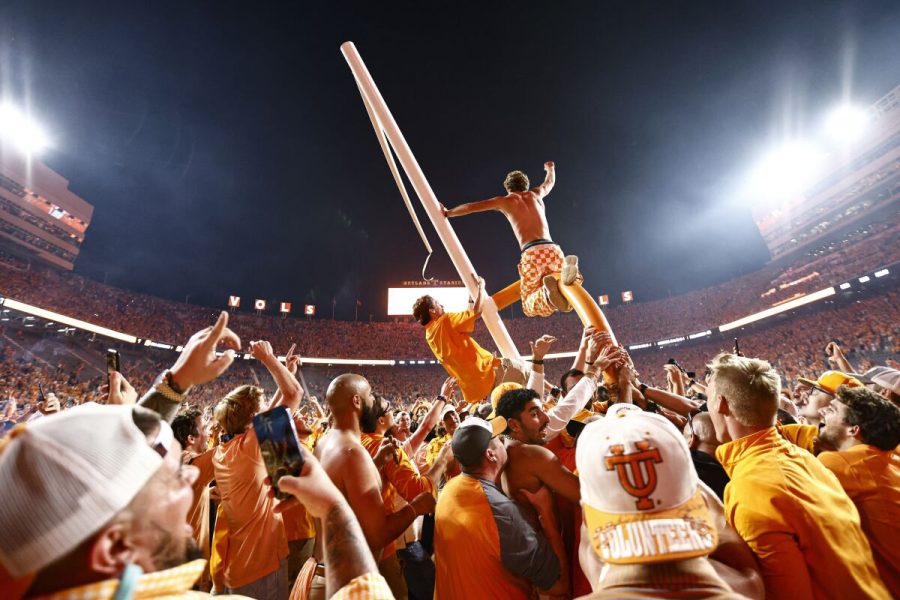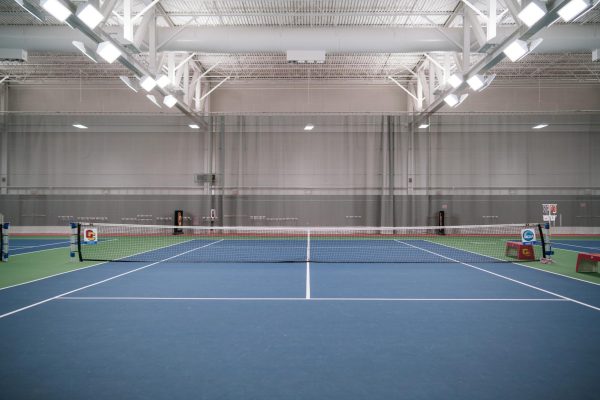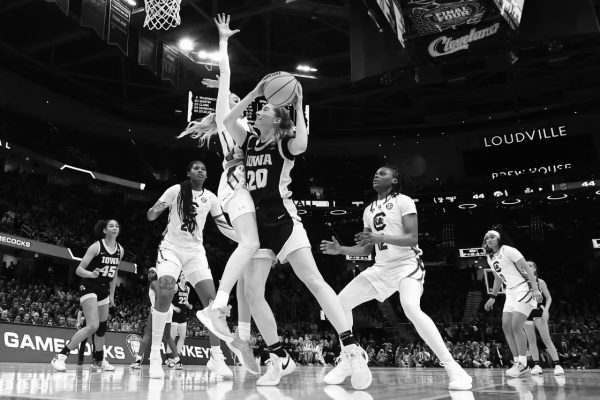Gameday Riots Reflect Poorly on Athletic Culture
University of Tennessee football fans ride atop a goalpost after an upset against the University of Alabama.
On Oct. 15, University of Tennessee fans stormed Neyland Stadium in celebration when the Volunteers ended a 16-year drought and took down the Alabama Crimson Tide in a close 52–49. The contagious, overwhelming joy quickly transformed into a riot, with fans removing the Volunteers’ goalposts and throwing them in the Tennessee River. One fan was caught removing a square of the checkerboard pattern in the endzones, while many more left broken glass and burnt cigar ends littered on the turf.
Despite this destruction, the general reaction from the media and fans was incredibly positive, with many celebrating the destructive and costly acts of jubilation.
“Here comes everybody, joining in the celebration,” commentator Bob Kesling said. “The student section mobbing the field! What jubilation in Big Orange Country!”
What many fans and media outlets did not take into consideration were the effects of removing the goalposts, tearing up the grass, and leaving shattered glass strewn across the field. It took the field crew until 2 a.m. to clean up the mess left behind. Darren Seybold, University of Tennessee’s director of sports surface management, had quite the task ahead of him: perfecting the field, missing goalposts and all, before Tennessee’s home game the following Saturday. However, even he found the actions of fans to be condonable.
“You figure, bud, in ’98 and 2022, I mean, that’s what, a 24-year difference?” Seybold said in an interview with ESPN’s Dave Wilson, alluding to the last time these fans stormed the field. “We’ll take the $100,000 fine and move on. … The goalposts comin down, you kind of expect it.”
Seybold’s comments beg the question: are illegal actions justifiable with time? Sure, this was Tennessee’s most important win since 1998, but storming the field has become increasingly popular and more frequent in the last few seasons of college football. These riots are seen as the ultimate fan support, and the euphoria that courses through the fans supposedly justifies the destruction and havoc they cause. Their enthusiasm and constant, fervid support is perceived to negate the monetary cost the college accrues.
In 2002, riots after Ohio State’s 14–9 victory over the University of Michigan resulted in cars being flipped and burned. When the University of Maryland defeated Indiana University in the NCAA Men’s Basketball Championship on April Fools Day 2002, Maryland fans ate glass, lit fires, and damaged emergency vehicles in their victory riot.
However, riots have ignited over more than big wins. After Joe Paterno, Penn State’s head football coach, was fired in 2011 for purposefully overlooking Assistant Coach Jerry Sandusky’s role in the Penn State child sex abuse scandal, fans got together and chanted in protest of Paterno’s dismissal. They flipped over a media van and caused immense damage before police dispersed the crowd.
One fan, Andrew Ezzart, explained the reasoning of the crowd to ESPN.
“People on the outside probably think we’re just a bunch of crazy kids acting stupid,” Ezzart said. “But for us, it’s so much more than that. We definitely don’t like the way they handled the situation. Everybody thinks they made Joe a scapegoat and this was all pinned on him.”
These riots, taking place at many colleges and universities, raise a concern about Oberlin: does the culture of rioting apply here?Some teams, such as the women’s basketball and track and field teams, have excelled recently, but greatness rarely falls upon Oberlin athletics.
Nonetheless, Oberlin sports fans are passionate and unwavering in their support. The student body regularly turns out for football and soccer games, especially when Oberlin is playing a division rival. Although the football team has had little success in recent history, they still manage to accumulate a large group of fans every week.
Even though Oberlin fans are passionate, their glee in victory does not translate into violence or chaos, with games seen as light-hearted entertainment instead of life-or-death battles, as they should be.






